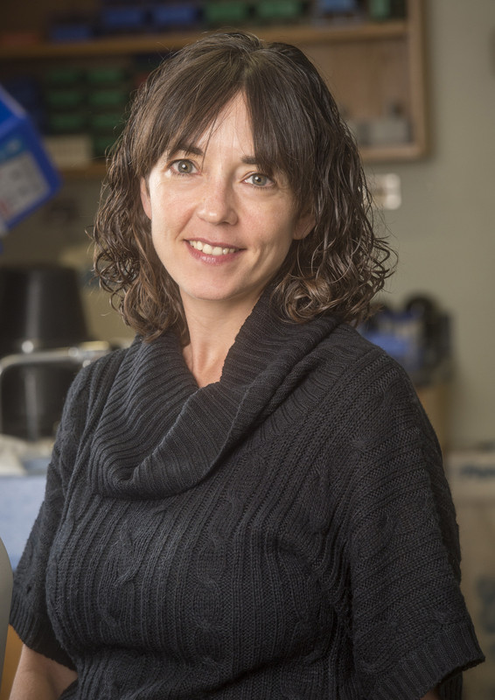BIRMINGHAM, Ala. – Immunologists have long been baffled by LPS, the bacterial lipopolysaccharide that helps form the cell walls of Gram-negative bacteria.

Credit: UAB
BIRMINGHAM, Ala. – Immunologists have long been baffled by LPS, the bacterial lipopolysaccharide that helps form the cell walls of Gram-negative bacteria.
Many experiments show that exposure to LPS during exposure to environmental allergens protects against developing asthma or allergic disease. Yet other numerous experiments show that the presence of LPS during exposure to environmental allergens does the opposite — it promotes the development of asthma and other allergic disease.
Now Beatriz León, Ph.D., and fellow University of Alabama at Birmingham researchers have cut this Gordian knot in a study published in Cell Reports. They detail a series of mechanistic steps that reveal a surprising answer — the key to LPS’ promoting or preventing the allergic reaction lies in the allergen itself.
Greater understanding of the mechanisms underlying sensitization to allergic disease can offer new strategies to control allergic airway disease, especially asthma. A global epidemic of asthma, including a sharp increase in developed countries since the 1960s, affects about 300 million children and adults worldwide.
León and her UAB colleagues unraveled a complex trail for the antagonistic mechanisms of LPS to promote or prevent allergic disease through activation or suppression of T helper-2 immune cells.
Here are their findings, which also define specific roles for immune cells called classical monocytes and non-classical monocytes.
First, the presence of cysteine protease enzymatic activity in an airborne allergen is required for bacterial LPS to have its protective effect. Allergens that contain cysteine protease enzymatic activity — like house dust mites or papain, an enzyme from papayas — lead to prevention of sensitization in the presence of LPS. In contrast, the German cockroach airborne allergen, which lacks cysteine protease activity, promotes sensitization, despite the presence of LPS.
The cysteine protease acts through a still unknown mechanism to induce non-classical monocytes in the lungs to produce the cytokine GM-CSF, or granulocyte-macrophage colony-stimulating factor. GM-CSF signaling governs the ability of LPS to suppress T helper-2 responses to allergens like house dust mites.
“Consequently, because the protective effects of LPS depend on GM-CSF, the beneficial effects of LPS are restricted to allergens that have cysteine protease activity,” León said.
In the absence of GM-CSF, LPS can favor pathogenic T helper-2 cell responses by supporting the trafficking of lung migratory dendritic cells into the lung-draining lymph nodes, where they can help initiate an immune response. However, when non-classical monocytes produce GM-CSF, LPS and GM-CSF synergize to differentiate classical monocytes into monocyte-derived dendritic cells that instruct the lung migratory dendritic cells for the suppression of T helper-2 cell allergic airway inflammation, through the production of interleukin-12.
“Our results show that GM-CSF segregates the opposed functions LPS has in the priming of allergen-specific T helper-2 cell responses,” León said. “Different host sensitivities to GM-CSF and/or LPS — influenced by genetic diversity or by environmental factors — can therefore significantly affect the risk of allergic sensitization. Understanding these interactions may provide insight into future therapeutic interventions to circumvent and even reverse allergic disease.”
The study, “GM-CSF production by non-classical monocytes controls antagonistic LPS-driven functions in allergic inflammation,” involved different allergen sensitization in mouse models, transcriptional analysis, and in vivo loss-of-function and gain-of-function experiments.
Co-authors with León, an associate professor in the UAB Department of Microbiology, are
Kamaljeet Kaur, Crystal Lewis and Alexander F. Rosenberg, UAB Department of Microbiology; and Holly Bachus, Amber M. Papillion and André Ballesteros-Tato, UAB Department of Medicine, Division of Clinical Immunology and Rheumatology.
Support came from National Institutes of Health grants AI116584 and AI150664, and from UAB. Microbiology and Medicine are departments in the UAB Marnix E. Heersink School of Medicine.
Journal
Cell Reports
DOI
10.1016/j.celrep.2021.110178
Method of Research
Experimental study
Subject of Research
Animals
Article Title
GM-CSF Production by Non-Classical Monocytes Controls Antagonistic LPS-driven Functions In Allergic Inflammation
Article Publication Date
28-Dec-2021
COI Statement
None




